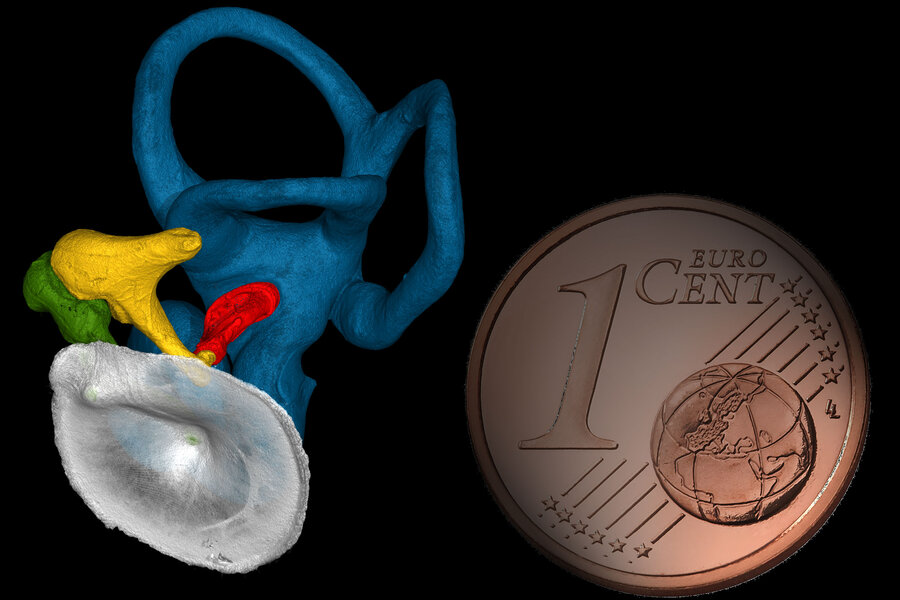Could Neanderthals hear the same sounds as humans?
Loading...
Tantalizing clues like cave art, and Neanderthal-constructed tombs and other edifices, hint that humanity's archaic relatives were capable of complex thought. More evidence that Neanderthals were remarkably human lies in the genomes, as all non-African modern humans have about 1 to 4 percent Neanderthal genetic material, thanks to interbreeding.
Complex vocal communication is one trait that is often considered particularly human: Homo sapiens, that is. But Neanderthals, H. neanderthalensis, might have been able to pick up on more than just grunts.
For clues into what Neanderthals might have heard, researchers compared the tiniest ear bones, the ossicles, in anatomically modern humans and Neanderthals.
At first glance, the ancient little bones seemed to be dramatically different from those in humans today. In fact, the structures were shaped more differently between the two human species than between gorillas and chimpanzees.
But when the team analyzed the function of the Neanderthal ear ossicles, they found that these bones transmit sound similarly as they do in modern humans. Their results are reported in a paper published Monday in the journal Proceedings of the National Academy of Sciences.
"If you look at the structure, it looks very different," study lead author Alexander Stoessel, of the Max Planck Institute for Evolutionary Anthropology, tells The Christian Science Monitor. "You intuitively think it also has to function differently, but it clearly showed that this is not the case."
And that could be a clue as to how Neanderthals were communicating with each other or understanding their environment.
"What's really interesting about these findings is the strong suggestion that, over [hundreds] of thousands of years of independent evolution, both Neanderthals and modern humans converged on a functionally very similar result in terms of hearing, but via separate evolutionary routes," Stephen Wroe, director of the Function, Evolution & Anatomy Research Lab at the University of New England in Australia who was not part of the study, writes in an email to the Monitor. "What was the selective pressure that drove this? The authors reasonably speculate that it was the evolution of speech and complex language."
But ear ossicles are just one part of the equation, cautions Dr. Stoessel. "There's more to language than just the hearing part," he says. For example, the way the brain processes information, how the tongue moves, and the larynx – or voice box.
And the ossicles are just one part of the ear and hearing process, Stoessel explains. A sound is transmitted through the tympanic membrane, or the eardrum. The eardrum then vibrates, and that vibration is picked up by the chains formed by the three ossicles, the ossicular chains. The ossicles serve to amplify the vibrations so that the sensory organs in the inner ear can pick them up more easily.
Previous research has also found that other parts of the ear, like the cochlea, that are important in determining which frequencies an animal can hear also function the same in Neanderthals and anatomically modern humans. So, Stoessel says, there is no evidence that both human species couldn't hear the same range of frequencies.
Linguist and cognitive scientist Philip Lieberman, a professor emeritus at Brown University, isn't surprised Neanderthals could likely hear speech like modern humans. Citing research that found dogs can understand language, he tells the Monitor, "If dogs can understand speech, Neanderthals could, too."
Still, that doesn't prove Neanderthals could speak, says Cheryl Hill, an assistant professor in the pathology and anatomical sciences department at the University of Missouri-Columbia. "Speech and hearing can totally be separated, even in modern humans," she says. "You have modern humans that can speak but can't necessarily hear and vice versa. Those are two different parts of the body."
Previous research has focused on parts of the body that specifically support the act of speaking. For example, a fossilized Neanderthal hyoid bone seems to be remarkably like what humans have today. That horseshoe-shaped structure supports the tongue, which in turn is crucial for the ability to speak.
Subsequent research on that hyoid found more evidence that the bony neck structure was used the same way in Neanderthals as it is in anatomically modern humans.
Still, the best evidence for speech would be if paleoanthropologists found a Neanderthal larynx, says Dr. Hill. "That would tell us a lot about if they could speak, but we don't have that information. Soft tissue doesn't survive in the fossil record."
Given the structure of their vocal tracts, Dr. Lieberman suggests perhaps Neanderthals could have had speech "capable of transmitting the nuances of language, albeit with less clarity and perhaps less efficiently" than anatomically modern humans.
"As humans, we always try to point out the differences between modern humans and Neanderthals to show that these are the different ones," Stoessel says. "But now our research shows actually how similar they were to us. They were not that different from us than probably some might want to think."
The ability to speak or have language is often considered fundamental to what makes us human, Dr. Wroe, who was an author of the study examining the Neanderthal hyoid, told BBC News in 2013. And by that reasoning, he said, "If Neanderthals also had language then they were truly human, too."









